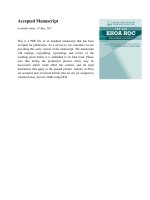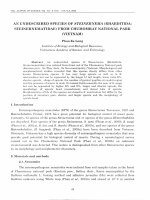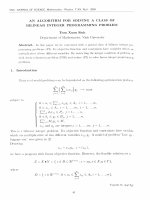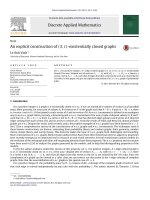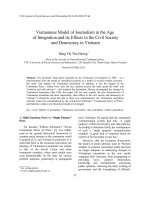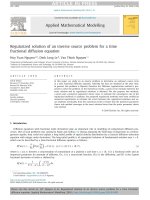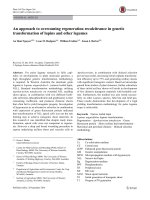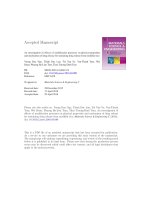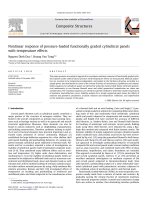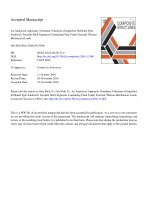DSpace at VNU: An investigation of effects of modification processes on physical properties and mechanism of drug release for sustaining drug release from modified rice
Bạn đang xem bản rút gọn của tài liệu. Xem và tải ngay bản đầy đủ của tài liệu tại đây (700.42 KB, 28 trang )
ÔØ Å ÒÙ× Ö ÔØ
An investigation of effects of modification processes on physical properties
and mechanism of drug release for sustaining drug release from modified rice
Vuong Duy Ngo, Thinh Duc Luu, Toi Van Vo, Van-Thanh Tran, Wei
Duan, Phuong Ha-Lien Tran, Thao Truong-Dinh Tran
PII:
DOI:
Reference:
S0928-4931(16)30412-X
doi: 10.1016/j.msec.2016.04.098
MSC 6478
To appear in:
Materials Science & Engineering C
Received date:
Revised date:
Accepted date:
28 December 2015
15 April 2016
29 April 2016
Please cite this article as: Vuong Duy Ngo, Thinh Duc Luu, Toi Van Vo, Van-Thanh
Tran, Wei Duan, Phuong Ha-Lien Tran, Thao Truong-Dinh Tran, An investigation of
effects of modification processes on physical properties and mechanism of drug release
for sustaining drug release from modified rice, Materials Science & Engineering C (2016),
doi: 10.1016/j.msec.2016.04.098
This is a PDF file of an unedited manuscript that has been accepted for publication.
As a service to our customers we are providing this early version of the manuscript.
The manuscript will undergo copyediting, typesetting, and review of the resulting proof
before it is published in its final form. Please note that during the production process
errors may be discovered which could affect the content, and all legal disclaimers that
apply to the journal pertain.
ACCEPTED MANUSCRIPT
An investigation of effects of modification processes on physical properties and
mechanism of drug release for sustaining drug release from modified rice
IP
T
Vuong Duy Ngo1, Thinh Duc Luu1, Toi Van Vo1, Van-Thanh Tran3, Wei Duan2, Phuong HaLien Tran2,* and Thao Truong-Dinh Tran1,*
1
2
SC
R
Pharmaceutical Engineering Laboratory, Biomedical Engineering Department,
International University, Vietnam National University – Ho Chi Minh City, Vietnam
School of Medicine, Deakin University, Pigdons Road, Waurn Ponds, Victoria, Australia
Faculty of pharmacy, University of medicine and pharmacy, Ho Chi Minh City
AC
CE
P
TE
D
MA
NU
3
*Correspondence to:
Thao Truong-Dinh Tran ()
Phuong Ha-Lien Tran ()
1
ACCEPTED MANUSCRIPT
Abstract
The aim of this study was to investigate the effect of modification processes on
T
physical properties and explain the mechanism of sustained drug release from modified rice
IP
(MR). Various types of Vietnamese rice were introduced in the study as the matrices of
SC
R
sustained release dosage form. Rice was thermally modified in water for a determined
temperature at different times with a simple process. Then tablets containing MR and
isradipine, the model drug, were prepared to investigate the capability of sustained drug
NU
release. Scanning electron microscopy (SEM) was used to determine different morphologies
MA
between MR formulations. Flow property of MR was analyzed by Hausner ratio and Carr’s
indices. The dissolution rate and swelling/erosion behaviors of tablets were evaluated at pH
1.2 and pH 6.8 at 37 ± 0.5°C. The matrix tablet containing MR showed a sustained release as
TE
D
compared to the control. The SEM analyses and swelling/erosion studies indicated that the
morphology as well as swelling/erosion rate of MR were modulated by modification time,
CE
P
drying method and incubation. It was found that the modification process was crucial because
it could highly affect the granule morphologies and hence, leading to the change of
AC
flowability and swelling/erosion capacity for sustained release of drug.
Keywords: modified rice, flow property, sustained release, morphology, incubation
2
ACCEPTED MANUSCRIPT
1. Introduction
Hydrophilic polymer matrices have been widely used in formulations of sustained
T
release (SR) systems to achieve slow release of drug over an extended period of time [1-4]
IP
due to low cost, ease of manufacture and relative independence of the physicochemical
SC
R
and physiological conditions of the gastrointestinal tract [5, 6]. Generally, the hydrophilic
polymer hydrates when it exposes to dissolution medium to form the gel layer as the barrier
controlling drug release. Hydroxypropyl methylcellulose (HPMC), hydroxypropyl cellulose
NU
(HPC), hydroxyethyl cellulose (HEC), xanthan gum, sodium alginate, poly (ethylene
used as hydrophilic matrices [7-11].
MA
oxide) and crosslinked homopolymers and copolymers of acrylic acid are commonly
D
Rice has been widely used in food industry and direct food use [12]. Despite
TE
promising characteristics of a safe material with starch component adding up to almost 90%
of milled rice [13], its application in pharmaceutical industry is still limited. Recently, starch
CE
P
has been considered as a promising biomaterial in pharmaceutical industry due to the unique
physicochemical and functional characteristics [14-16]. Native starches have been well
AC
explored as binders and disintegrants in solid dosage forms; however, the utilization is
restricted due to poor flowability. Meanwhile, modified starches have been investigated for
applications of sustained release agents as hydrophilic matrices [17-21] in drug delivery
systems. Starch-based biodegradable polymers used in preparation of microspheres or
hydrogels have been studied for drug delivery [22, 23]. Starch like rice starch could be
modified by chemical, physical or enzymatic methods to have distinctive properties.
Mechanism of drug release from modified rice matrices would be a result of the passage of
drug molecules controlled by the matrix structure and gel layer formation.
The granular structure and swelling ability in cold water of native starches have been
investigated by physical modifications such as extrusion, drum-drying and a controlled
3
ACCEPTED MANUSCRIPT
pregelatinization-spray-drying [17]. However, few studies have investigated thermal
modification on physical properties and changes of drug release mechanism from modified
T
rice in details so far. The study introduced various types of Vietnamese rice as possible
IP
carriers for sustained release of drug in a simple process with common apparatuses. The
SC
R
potential rice was selected for further use in investigation of effects of modifying time,
incubation method, and drying method on the flow property, granule morphology, swelling
and erosion capacity of modified rice-based tablets. Hence, dissolution profiles of tablets,
NU
analysis of flowability, SEM images as well as swelling and erosion studies were carried out
MA
in the study.
TE
D
2. Materials and Methods
2.1 Materials
CE
P
Various types of Vietnamese rice which were harvested and packed in the same year
(2014) were introduced in the study: Nep Bac (NB) from Xuan Hong company (Viet Nam),
AC
Nep Thom (NT) from Gentraco Corporation (Viet Nam), Vua Lieu (VL) from ITA Fragrant
Rice Research & Export Corporation (Viet Nam), Hoa Vang (HV) from Ngoc Hoan company
(Viet Nam). Rice packages were stored at room temperature (25 °C) for study.
Microcrystalline cellulose (Avicel® PH 102) was purchased from Brenntag Group
(Germany). Magnesium stearate (MgS) was purchased from Nitika Pharmaceutical
Specialities Pvt. Ltd (India). Hydrochloric acid (HCl) and Sodium chloride (NaCl) were
purchased from Xilong Chemical Industry Incorporated Company (China). Hydroxypropyl
methyl cellulose 4000 (HPMC) was provided by Dow Chemical Company (USA).
Polyethylene glycol (PEG) was purchased from Sino-Japan chemical (Taiwan). Methanol
(MeOH) was purchased from Fisher Scientific International, Inc (US). Monopotassium
4
ACCEPTED MANUSCRIPT
phosphate (KH2PO4) was purchased from Wako Pure Chemical Industries (Japan). Aerosil®
200 was from Jebsen & Jessen Chemicals Holding Pte Ltd (Singapore). Mannitol (Pearlitol®)
T
was purchased from Roquette Pharma Company, France.
SC
R
IP
2.2. Methods
2.2.1 Modification of rice
Four varieties of glutinous rice were milled and sieved by 500 μm sieve. Then, 15 g of
NU
each type of glutinous rice was dispersed in 150 mL of distilled water and incubated at 90 °C
for 4 h. The swelling rice was then heated in an oven at 120 °C with different times. The
MA
mucilage was dried in the oven at 60 °C or freeze-dried at –52 °C. The modified rice (MR)
was finally passed through 500 μm sieve. The detailed conditions for MR were described in
D
the Table 1.
CE
P
TE
Table 1. Method of rice-based tablet formulations
Incubation
time (h)
Type
of rice
Drying method
Code
120
8
4
NT
Oven at 60 °C
NT 8 h
F2
120
8
4
NB
Oven at 60 °C
NB 8 h
F3
120
8
4
HV
Oven at 60 °C
HV 8 h
F4
120
8
4
VL
Oven at 60 °C
VL 8 h
F5
120
10
4
NT
Oven at 60 °C
NT 10 h
F6
120
12
4
NT
Oven at 60 °C
NT 12 h
NT
Freeze-drying
at - 52 °C
NT 8 h
freezedrying
F1
F7
AC
Modifying
time
(h)
Formulation
Modified
Temperature
(oC)
120
8
4
5
ACCEPTED MANUSCRIPT
120
10
4
NT
F9
120
12
4
NT
Freeze-drying
at - 52 °C
F10
120
8
0
NT
Oven at 60 °C
NT 10 h
freezedrying
NT 12 h
freezedrying
NT 8 h
without
incubation
SC
R
2.2.2 Preparation of prolonged release tablet
IP
T
F8
Freeze-drying
at - 52 °C
Solid dispersion of isradipine was prepared by melting method. Briefly, mixture of
NU
polymer (PEG:HPMC=1:1) and drug at the ratio 8:1 was melted at 160 oC. Drug was
dispersed in the melted polymer. Aerosil® 200 was used as a sorbent of solid dispersion
MA
(Aerosil® 200: solid dispersion = 1:3). The resultant mixture was passed through a 500 μm
sieve and thoroughly mixed with MR and mannitol. Finally, MgS was blended with the above
D
mixture which was then compressed into tablets of diameter 8mm using a single punch-press
TE
machine (TDP 1.5, China). Hardness of the tablets was controlled at 30 ± 5 N. Each 150 mg
mg MgS.
CE
P
tablet contained 60 mg solid dispersion of isradipine, 20 mg MR, 68.5 mg mannitol and 1.5
2.2.3 Dissolution studies
AC
The tablets were introduced to an in vitro dissolution test at 37 ± 0.5 °C using type II
apparatus dissolution tester (DT70 Pharmatest, Germany) at 50 rpm. To evaluate capability of
sustained drug release, each dissolution vessel contained 750 ml of 0.1N hydrochloric acid
(pH 1.2) for 2 h and then the pH of the medium was adjusted to pH 6.8 by adding 250 mL of
0.2 M sodium phosphate solution, preheated to 37 °C (2 M hydrochloric acid or 2 M sodium
hydroxide was used for minor pH adjustment) [24]. 1ml of sample was collected from the
media at 1, 2, 6, 10, 14, 18, and 24 h. 100 µl sample solutions were diluted for HPLC test.
2.2.4 High performance liquid chromatography (HPLC) analysis
6
ACCEPTED MANUSCRIPT
The quantification of isradipine was performed using Ultimate 3000 HPMC
Thermoscientific Inc., USA. The mobile phase contained Methanol: Water: Acetonitrile
T
mixture at the ratio 46 %, 20 % and 34 %, respectively with a flow rate of 1.00 ml/min and
IP
the running time was 4 min. The UV/VIS detector was set at a wavelength of 325 nm. 20 µL
SC
R
of sample was injected to HPLC system.
2.2.5. Flow property test
The Carr’s compressibility index and the Hausner ratio were calculated to provide a
NU
measure of the flow properties and compressibility of MR powders. However, firstly bulk
MA
and tap densities of MRs were determined before and after 1250 taps, respectively, using the
tap density tester (SVM, ERWEKA GmbH, Germany).
(1)
bulk density
(tapped density−bulk density)
CE
P
Carr index =
tapped density
TE
Hausner ratio =
D
The Hausner ratio and Carr’s index was determined as follows:
tapped density
X 100
(2)
AC
2.2.6. Scanning Electron Microscopy (SEM)
Samples were stuck onto conductive carbon adhesive tape. The morphology was then
examined under the scanning electron microscope (Hitachi’s S-4800 FE-SEM, Japan).
2.2.7. Swelling and erosion studies
The rate of MR swelling was determined by equilibrium weight gain method [25].
Tablets were accurately weighed (W0) and put in sinkers to conduct the swelling test using
the USP II apparatus (50 rpm, 37 °C, and a 900 mL dissolution medium of buffer pH 1.2 and
buffer pH 6.8) with a dissolution tester (DT70 Pharmatest, Germany). Sinkers of tablets were
carefully removed from the media after 1, 2 and 6 h and the tablets were lightly blotted with
7
ACCEPTED MANUSCRIPT
tissue paper to remove excess surface water and then reweighed (Wt). The percent water
uptake or swelling rate due to absorbed liquid was estimated at each time point using Eq. (3):
Matrix swelling (%) = (Wt−W0)/W0 x 100
(3)
IP
T
Wt: weight at time t (1 h, 2 h, 6 h)
SC
R
W0: initial weight
Matrix erosion study was performed by a method of Roy and Rohera [26]. After the
swelling study, the wet samples were then dried in an oven until the samples were completely
MA
erosion at time t was estimated from Eq. (4)
NU
dried and finally weighed until a constant weight was achieved (Wd). The percentage matrix
Matrix erosion (%) = (W0−Wd)/W0 x 100
D
W0: initial weight
(4)
CE
P
TE
Wd: weight after drying
3. Results and discussion
3.1 Dissolution studies
AC
3.1.1 Effect of types of rice
The drug release behaviors depend on type of the matrix, capability of swelling,
diffusion and erosion process [27]. Hydrophilic polymers are commonly used to control
release of drug due to their capability of swelling in the presence of water and forming a gellike substance. To compare effect of types of rice on dissolution rates, the samples (NT, NB,
VL, HV) were prepared under the following conditions: incubating at 90 ºC for 4 h, heating at
120 ºC for 8 h, and then drying in an oven (F1, F2, F3, F4). The NT tablets showed more
sustained release rates than NB, VL and HV tablets (Figure 1). Specifically, after 1 h the
drug dissolution release of NT, NB and VL tablets were 24.6 %, 26.45 % and 28.4 %,
respectively, while the dissolution rate of HV tablets was 35.3 %. After 2 h, the dissolution
8
ACCEPTED MANUSCRIPT
rate of NT, NB and VL tablets was increased to about 30 % of drug released but the
difference between these formulations was not significant; whereas, the dissolution profile of
T
HV tablets was still at the highest which was 50.0 % drug released. After 6 h, while the drug
IP
dissolution release of NB and VL tablets was enhanced to over 74.0 % similar to that of HV
SC
R
tablets, the dissolution rate of NT tablet was at the lowest of 56.0 % drug released. The
release patterns of these tablets with the lowest dissolution rate of NT were also occured until
18 h, indicating that NT would be a potential rice to prolong the release of drug. Physical
NU
modification of rice would lead to changes of granular structures and conversion of native
MA
rice into cold water-soluble rice or small-crystallite rice [28]. Mechanism of drug release
from such gel-forming matrices would elucidate those different release patterns. Hence, NT
TE
D
was selected for further studies.
CE
P
120
80
60
AC
Drug release (%)
100
40
NB 8 h oven drying
NT 8 h oven drying
VL 8 h oven drying
HV 8 h oven drying
20
0
0
5
10
15
Time ( Hours )
9
20
25
ACCEPTED MANUSCRIPT
Figure 1. Effects of types of rice incubated at 90 ºC for 4 h, heated at 120 ºC for 8 h, and
dried in the oven on drug dissolution (n=3).
IP
T
3.1.2 Effect of modifying time and drying method
To investigate the effect of modifying time on dissolution rate, NT samples were
SC
R
prepared by the following conditions: incubating at 90 ºC for 4 h, heating at 120 ºC in 8 h, 10
h and 12 h, and finally drying in the oven or freeze drier. Figure 2 shows the effect of time in
NU
the modification process followed by drying in the oven on the dissolution rate of tablets. By
increasing the time of heating from 8 h to 10 h and 12 h (F1, F5 and F6, respectively), the
MA
modified rice could not retard the dissolution rate. Conversely, the increased time reduced the
ability of sustained drug release from the tablets. At the time points from 2 h to 6 h, there was
D
an explosion of the drug release from NT heated in 10 h (increased from 33.4 % to 75.0 %)
TE
and NT heated in 12 h (increased from 33.9 % to 98.5 %), while the dissolution rate of NT
CE
P
heated in 8 h was moderately increased from 28.4 % to 49.3 %. The drug release was
increased slowly in the next hours until the end of the dissolution. Similar results were also
observed with the samples which were dried by freeze-drying method (F7, F8 and F9)
AC
(Figure 3). These results indicated that the longer modifying time may cause the higher
dissolution rate and it would be a critical factor to consider for being optimized in the thermal
modification process.
10
ACCEPTED MANUSCRIPT
120
T
IP
SC
R
80
60
NU
Drug release (%)
100
40
NT 8 h oven drying
NT 10 h oven drying
NT 12 h oven drying
MA
20
5
TE
0
D
0
10
15
20
25
Time ( Hours )
CE
P
Figure 2. Effects of modifying time on dissolution rate of tablets of NT incubated at 90
AC
ºC for 4 h, heated at 120 ºC and dried in the oven (n=3).
11
ACCEPTED MANUSCRIPT
120
T
IP
80
60
SC
R
Drug Release (%)
100
40
NU
20
0
5
10
15
20
25
MA
0
NT 8 h freeze drying
NT 10 h oven drying
NT 12 h freeze drying
Time ( Hours )
D
Figure 3. Effect of modifying time on dissolution rate of tablets of NT incubated at 90 ºC
TE
for 4 h, heated at 120 ºC and dried by freeze drier (n=3).
CE
P
For further investigation of the effect of drying method on drug release rate, two NT
samples which were modified in 8 h and 12 h (dried by the freeze-drying and oven method)
were compared to each other in dissolution profiles (Figure 4). For 12 h modifying time,
AC
generally NT tablets using freeze-drying method (F9) was expressed lower drug dissolution
release than the tablets dried in the oven (F6). However, the dissolution rate of NT tablets
which were under 8h of modifying time and then introduced to the freeze-drying (F7) was
higher than the tablets dried in the oven (F1). Therefore, appropriate modifying time and
drying method would be needed for the formation of controlled release formulations. Effect
of drying method on the drug release will be investigated in the erosion and swelling studies
(section 3.3).
12
ACCEPTED MANUSCRIPT
120
T
IP
80
60
SC
R
Drug Release (%)
100
40
NT 8 h freeze drying
NT 8 h oven drying
NT 12 h freeze drying
NT 12 h oven drying
NU
20
0
0
5
10
15
20
25
MA
Time ( Hours )
Figure 4. Effects of freeze-drying and oven drying on dissolution rate of tablets of NT
TE
D
incubated at 90 ºC for 4 h and heated at 120 ºC (n=3).
CE
P
3.1.3 Effect of incubation method
To investigate the role of incubation for MR, the NT sample in water was directly
heated at 120 ºC for 8 h and dried in the oven. This MR was compared with the sample which
AC
was prepared in the same condition except for the additional incubation step before heating
the rice (F10 compared to F1). Figure 5 shows the effect of incubation method in the
modification process on the dissolution rate of tablets. For incubation method, there was a
sustained release after 2 h, increasing from 28.6 % to 49.3 % in the range of time points from
2 to 6 h. Then drug release was increased slowly at a constant rate during the next 18 h.
Meanwhile, from 2 h to 6 h, dissolution rate of the method without incubation was
significantly enhanced, which was twofold enhancement from 38.6 % to 84.2 %. These
results proved that the incubation method is one of the most important steps in modification
process for sustaining drug release.
13
ACCEPTED MANUSCRIPT
120
IP
SC
R
80
60
40
NU
Drug release (%)
T
100
20
NT 8 h incubated 4 h/ 90 0C dried 60 0C
NT 8 h without incubated dried 60 0C
0
MA
0
5
10
15
20
25
Time ( Hours )
dried in the oven (n=3).
TE
D
Figure 5. Effects of incubation method on dissolution rate of tablets of NT at 120 ºC and
CE
P
3.2. Flow properties and morphology of MR
Bulk and tapped density of different formulations were measured. Table 2 shows the
AC
Hausner ratio and Carr index, parameters for the measurement of flow properties of powders.
If Carr index (CI) or Hausner ratio (HR) of a material is lower than that of another one, it
indicates better flow properties. A CI <10 or HR <1.11 is considered ‘excellent’ flow;
whereas CI>38 or HR>1.60 is considered ‘very poor’ flow. Meanwhile, other values express
the scales as follows: intermediate scales for CI between 11–15 or HR between 1.12–1.18 is
considered ‘good’ flow, CI between 16–20 or HR between 1.19–1.25 is considered ‘fair’
flow, CI between 21–25 or HR between 1.26–1.34 is considered passable flow, CI between
26–31 or HR between 1.35–1.45 is considered ‘poor’ flow, and CI between 32–37 or HR
between 1.46–1.59 is considered ‘very poor’ flow [29]. It was found that flow of F1, F2, F4,
F5 and F10 were rated as “good”; whereas, F3, F6, F7, F8 and F9 were cohesive and ranged
14
ACCEPTED MANUSCRIPT
from “passable flow” to “poor flow”. Although the incubation method including the
modifying process could retard the dissolution rate of drug, there was an insignificant change
T
of flow properties (F1 compared to F10). Also, the flow properties depended on the types of
IP
rice, for instance, F3 (HV) was passable while F1 (NT), F2 (NB) and F4 (VL) had good flow.
SC
R
Moreover, the increase of modifying time could reduce the flowability of MR, in which the
increase of modifying time from 8 h to 10 h still ensured a good flowability, while 12 h of the
modifying time resulted in fair flowability. More importantly, the oven-dried samples showed
NU
that drying using the oven was more suitable than freeze-drying method to have good powder
Carr index (%)
Comment
1.16
13.79
Good flow
1.13
11.50
Good flow
F3
1.30
23.08
Passable flow
F4
1.14
12.28
Good flow
F5
1.13
11.50
Good flow
F6
1.26
20.63
Fair flow
F7
1.39
28.06
Poor flow
F8
1.40
28.57
Poor flow
F9
1.41
29.08
Poor flow
F10
1.13
11.50
Good flow
F1
AC
F2
Hausner ratio
CE
P
Formulation
TE
D
Table 2. Physical properties of MRs
MA
flowability.
15
ACCEPTED MANUSCRIPT
Furthermore, SEM micrographs of NT rice granules before and after modification
T
were used to explain the flowability of rice granules (Figure 6). Native NT rice showed a
IP
specific angular shape and rather uneven surface (Figure 6A). When comparing the two
SC
R
methods, images of the MR from the oven drying method show cubic form (Figure 6B,
Figure 6C and Figure 6F). Meanwhile, in the freeze-drying method, MR had large adhesive
plaque form and numerous foam-like shapes were observed on surface of the samples
NU
(Figure 6D and Figure 6E). These results demonstrated that the good flowability of the
MA
samples dried in the oven was the consequence of preferable shape of the samples. The
comparison between images of the samples under oven drying time of 8 h (Figure 6B and
D
Figure 6F) and 12h (Figure 6C) indicated that the longer modifying time, the more
TE
indentations on surface of the particles, leading to the worse flow properties of the samples.
Overall, these results suggested that modifying time and drying method generated the
CE
P
morphology of granules which mainly contributed to the flowability of MR facilitating the
AC
tablet compression process.
16
CE
P
TE
D
MA
NU
SC
R
IP
T
ACCEPTED MANUSCRIPT
AC
Figure 6. SEM pictures with magnifications of 2000 of native NT rice (A); F1 (B); F6
(C); F7 (D); F9 (E); F10 ( F).
3.3. Swelling and erosion analyses
Figure 7A shows effects of types of rice on swelling and erosion during dissolution
process. Tablets from NT rice with 8h of modifying time had the highest swelling rate, which
could be related to its lower erosion compared to tablets of NB, VL and HV. In details, at the
time point of 1h, the swelling rate of NB, VL and HV tablets around 21.2-23.4 % while the
swelling rate of NT tablets was 26.5 %. At the time point of 2 h, the swelling rate of tablets
from NT, NB, VL and HV increased to 26.2-31.6 %. However, after 6 h, while the swelling
rate of NB, VL and HV tablets were approximately 35 %, the swelling rate of NT tablets was
significantly increased to 52.4 %. In addition, Figure 7B shows the results of erosion studies.
17
ACCEPTED MANUSCRIPT
HV tablets got the highest erosion rate, while NT-modified tablets had the lowest erosion
rate. These results could be explained by the formation of a gel layer around the tablet under
T
swelling. Therefore, various types of rice would have distinct capability of swelling and
IP
erosion by modification. The highest rate of swelling and the lowest erosion rate of NT could
SC
R
be attributed to the capability of this rice in prolonging drug release.
60
NU
A
50
MA
Swelling (%)
40
30
D
20
0
1
2
CE
P
0
TE
10
NB 8 h oven drying
NT 8 h oven drying
VL 8 h oven drying
HV 8 h oven drying
3
4
5
6
7
Time ( Hours )
AC
18
B
16
14
Erosion (%)
12
10
8
6
NB 8 h oven drying
NT 8 h oven drying
VL 8 h oven drying
HV 8 h oven drying
4
2
0
0
1
2
3
4
5
6
7
Time ( Hours )
Figure 7. Effects of types of rice on swelling (A) and erosion (B) behaviors of tablets of NT
incubated at 90 ºC for 4 h, heated at 120 ºC for 8 h and dried in the oven (n=3).
18
ACCEPTED MANUSCRIPT
The modifying time was also investigated its effects on the swelling and erosion of
MR. After exposing in dissolution media for 1 h, NT tablets which were modified for 8 h, 10
T
h and 12 h had a swelling rate at around 23.7-26.5 % (Figure 8A). However, after 6 h, the
IP
swelling rate of NT sample with 8 h of modifying time was significantly enhanced from 31.6
SC
R
% to 52.4 %, while the swelling rate of NT modified for 12 h suddenly declined from 28.7 %
to 15.4 %. This phenomenon was due to the faster erosion of NT with modification for 12 h
(Figure 8B). On the other hand, the lowest erosion rate of NT was observed with 8h
NU
modification. The increase of modifying time hence could decrease the swelling rate and
MA
increase the erosion, which led to the reduction in drug release. Furthermore, these results
were also explained by the fact that the increase of time in modification could increase
D
numerous depressions on the granule surface (Figure 6B and Figure 6C) which caused NT
AC
CE
P
TE
modified for 12 h prone to erosion.
19
ACCEPTED MANUSCRIPT
60
A
T
50
IP
SC
R
Swelling (%)
40
30
20
NU
NT 8 h oven drying
NT 10 h oven drying
NT 12 h oven drying
10
0
1
2
3
MA
0
4
5
6
7
D
Time ( Hours )
B
CE
P
10
AC
Erosion (%)
15
TE
20
5
NT 8 h oven drying
NT 10 h oven drying
NT 12 h oven drying
0
0
1
2
3
4
5
6
7
Time ( Hours )
Figure 8. Effects of modifying time on swelling (A) and erosion (B) behaviors of tablets of
NT incubated at 90 ºC for 4 h, heated at 120 ºC and dried in the oven (n=3).
In addition to modifying time, effects of drying method were also investigated
through swelling and erosion studies. Figure 9A shows that there were negligible differences
between the swelling rate of NT 8 h oven drying and NT 8 h freeze-drying, while the
20
ACCEPTED MANUSCRIPT
swelling rate between NT 12 h oven drying and NT 12 h freeze-drying had significant
differences. Specifically, from 2 h to 6 h, the swelling rate of NT 8 h freeze drying and NT 8
T
h oven drying increased remarkably from 33.4 % to 56.5 % and 31.6 % to 52.4 %,
IP
respectively. The swelling rate of NT 12 h freeze-drying slowly increased from 29.4 % to
SC
R
36.5 % (from 2 h – 6 h). However, the swelling rate of NT 12 h oven drying suddenly
decreased from 28.7 % to 15.4 %. Figure 9B illustrates the erosion rate of NT 8 h, 12 h under
oven drying method and NT 8 h, 12 h under freeze-drying method. There was insignificant
NU
difference in tablet erosion of MRs which were modified at 8 h. Meanwhile, the erosion rate
MA
between NT 12 h oven drying and NT 12 h freeze-drying had significant differences. For
instance, at the time point of 1 h the erosion rate of NT 8 h oven drying and NT 8 h freeze-
D
drying were around 4.8-5.8 %; whereas, the erosion rate of NT 12 h using oven drying and
TE
NT 12 h freeze-drying were 8.1 % and 6.1 %, respectively. After 6 h, the erosion of NT 8 h
oven drying and NT 8 h freeze-drying increased to 10.8 % and 11.7 %, correlatively.
CE
P
Nevertheless, the erosion rate of NT 12 h oven drying was 18.8 % different from 14 % of NT
12 h freeze-drying. Therefore, as comparing the swelling and erosion rate between two
AC
drying methods with the modification time of 8h, there was not much significant difference.
On the other hand, when increasing the modification time to 12 h, the oven drying method
strongly affected the swelling and erosion. Oven drying caused lower swelling rate, leading
to higher erosion of NT tablets. Therefore, freeze-drying method had a minor effect on
reduction of swelling rate as well as increment of erosion compared with oven drying, in
general. Effects of the swelling and erosion on morphology of the samples were discovered
through SEM images in the previous section (Figure 6B, Figure 6C, Figure 6D and Figure
6E). The presence of numerous foams at the surface of the samples that resulted from freezedrying method could facilitate water absorption for swelling even when increasing
modification time to 12 h.
21
ACCEPTED MANUSCRIPT
70
A
60
IP
40
30
SC
R
Swelling (%)
T
NT 8 h freeze drying
NT 8 h oven drying
NT 12 h freeze drying
NT 12 h oven drying
50
20
NU
10
0
0
1
2
3
4
5
6
7
5
6
7
MA
Time ( Hours )
25
D
B
TE
NT 8 h freeze drying
NT 8 h oven drying
NT 12 h freeze drying
NT 12 h oven drying
CE
P
15
10
AC
Erosion (%)
20
5
0
0
1
2
3
4
Time ( Hours )
Figure 9. Effects of drying method on swelling (A) and erosion (B) behaviors of tablets of
NT incubated at 90 ºC for 4 h and heated at 120 ºC (n=3).
Finally, effects of the incubation method on swelling and erosion were investigated.
The swelling rate of NT 8 h - incubation tablets which was incubated 4 h before modification
was 26.5 % at the time point of 1 h and increased steadily over time (Figure 10A). From 2 h
22
ACCEPTED MANUSCRIPT
to 6 h, the swelling rate of NT 8 h - incubation tablets increased considerably from 31.6 % to
52.4 %. On the other hand, at the time point of 1 h, the swelling rate of NT 8 h without
T
incubation was 21.8 % and decreased slowly from time to time. Hence, the incubation could
IP
enhance the swelling of modified rice. Additionally, Figure 10B indicates the erosion rate of
SC
R
NT 8h-incubation lower than that of NT 8 h without incubation. Therefore, the incubated rice
before modification not only could enhance the swelling but also decrease the erosion rate of
MR. These results could be explained thoroughly by morphology of the samples caused by
NU
modification processes. Numerous depressions on the granule surface were observed with the
MA
samples under incubation as comparing to the surface of samples without incubation (Figure
6C and Figure 6F), resulting in the improvement of water absorption of MR for favorable
D
swelling. However, the increase of modification time could lead to extensive depressions on
AC
CE
P
TE
the granule surface which facilitated the MR erosion.
23
ACCEPTED MANUSCRIPT
60
A
IP
T
50
SC
R
Swelling (%)
40
30
NU
20
10
MA
NT 8 h incubated 4 h / 90 0C dried 60 0C
NT 8 h without incubated dried 60 0C
0
0
1
2
3
4
5
6
7
20
16
Erosion (%)
AC
14
CE
P
B
18
TE
D
Time ( Hours )
12
10
8
6
4
NT 8 h incubated 4 h / 90 0C dried 60 0C
NT 8 h without incubated dried 60 0C
2
0
0
1
2
3
4
5
6
7
Time ( Hours )
Figure 10. Effects of incubation method on swelling (A) and erosion (B) behaviors of tablets
of NT at 120 ºC and dried in the oven (n=3).
24
